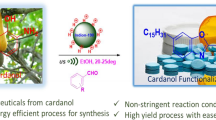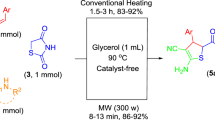Abstract
The ring opening between BCC with di-amine by conventional heating (130 °C for 48 h) is a time-consuming and non-efficient process. This work has been aiming at accelerating its ring-opening reaction by a microwave radiation process. Besides, catalyst and solvent selections of this PU reaction system, the microwave power output, radiation time, catalyst and reaction media were major consideration of this research. A catalyst, TBAC or LiBr had been applied on each microwave-assisted ring-opening polymerization of BCC with Jeffamine D-2000. A similar average molecular weight of NH2-PU oligomer was obtained from a 50 min microwave radiation by using 50 W power output. The radiation system with TBAC as catalyst, and it resulted in a formation of NH2-PU oligomer with Mn and Mw were 12,997 and 15,580, and that of 10,882 and 13,508 with LiBr as catalyst. The solvent polarity, catalyst solubility and microwave output energy in this radiation system were considered as important factors for this new green process.











Similar content being viewed by others
References
Dieterich D, Grigat E, Hahn W (1985) Chapter 2. In: Oertel G (ed) Polyurethane handbook. Carl Hanser, Munich, p 24
Chen GN, Chen KN (1997) Self-curing behaviors of single pack aqueous-based polyurethane system. J Appl Polym Sci 63:1609
Chen GN, Chen KN (1999) Dual-curing of anionic aqueous-based polyurethane at ambient temperature. J Appl Polym Sci 67:1661
Chen GN, Chen KN (1999) Hybridization from aqueous-based polyurethane and glycidyl methacrylate copolymer. J Appl Polym Sci 71:903
Shao CH, Wang TZ, Chen GN, Chen KJ, Yeh JT, Chen KN (2000) Aqueous-based polyurethane with dual-functional curing agent. J Polym Res 7:41
Huang WK, Yeh JT, Chen KN (2002) Curing of combustion properties of a PU coating system with UV-reactive phosphazene. J Appl Polym Sci 85:1980
Chen PC, Wang SC, Yeh JT, Chen JN (2007) New cross-linked polymer from a rapid polymerization of acrylic acid with Tri-aziridine containing compound. J Appl Polym Sci 104:809
Chen WH, Chen PC, Yeh JT, Chen KN (2009) Hydrophilic UV-curable PU resins for PET micro-fiber applications. J Polym Res 16:329
Chen WH, Chen PC, Wang SC, Yeh JT, Huang CY, Chen KN (2009) UV-curable PDMS-containing PU system for hydrophobic textile surface treatment. J Polym Res 16:601
Wang SC, Chen PC, Hwang JZ, Yeh JT, Huang CY, Chen KN (2012) Performance properties of self-curing aqueous-based PU system with tri-glycidyl phosphate curing agent. J Polym Res 19:9844
Wang SC, Chen PC, Yeh JT, Chen KN (2007) A New curing agent for self-curing system of aqueous-based PU dispersion. React Funct Polym 67:299
Lai JZ, Ling HJ, Yeh JT, Chen KN (2004) Single component self-curable aqueous-based PU system with New aziridinyl curing agent. J Appl Polym Sci 91:1997
Choudhary G, Peddinti RK (2011) An expeditious, highly efficient, catalyst-free and solvent-free synthesis of nitroamines and nitrosulfides by Michael addition. Green Chem 13:276
Chen PC, Wang SC, Hwang JZ, Yeh JT, Huang CY, Chen KN (2011) A New self-polymerization of acrylic acid with a mono-aziridine containing compound. J Chin Chem Soc 57:901
Little R, Masjedizadeh M, Wallquist O, Mcloughlin (1995) The intramolecular Michael reaction. J Org React 47:315
Mather B, Viswanathan K, Miller K, Long T (2006) Michael addition reactions in macromolecular design for emerging technologies. Prog Polym Sci 31:487
Moszner N, Volkel T, Clausbruch SC, Geiter E, Batliner N, Rheinberger V (2002) Sol–gel materials, 1. Synthesis and hydrolytic condensation of New cross-linking alkoxysilane methacrylates and light-curing composites based upon the condensates. Macromol Mater Eng 287:339
Wang SC, Chen PC, Hwang JZ, Huang CY, Yeh JT, Chen KN (2012) A new tri-functional azetidine compound for self-curing aqueous-based PU system. J Appl Polym Sci 124:175
Chen WH, Yeh JT, Huang CY, Chen KN (2008) UV-curable fluorine-containing IPN system for fabric water-repellency treatment. J Polym Eng 28:517
Hwang J-Z, Wang S-C, Chen P-C, Chen K-N (2011) Ambient temperature curable hydrophilic PU oligomer, method for synthesizing the same and surface treatment method of using the same. Patent US 8,053,488 B2
Chen W-H, Chen P-C, Wang S-C, Chen K-N (2010) Long-lasting water-repellent textile treatment process using an ambient temperature curable polydimethylsiloxane-containing polyurethane PU system. Patent US 2010/0092689 A1
Hwang J-Z, Wang S-C, Chen P-C, Chen K-N (2012) Preparing method for reactive hydrophilic polyurethane resins and their applications at ambient temperature. Patent ROC I 362394
Lee M-H, Shih Y-P, Chen K-N, Ni J-C (2008) A method for treating surface of textile. Patent ROC I297396
Chen WJ, Wang SC, Chen PC, Chen CW, Chen KN (2008) Hybridization of aqueous PU/epoxy resin via a dual self-curing process. J Appl Polym Sci 110:147
Wang SC, Chen PC, Yeh JT, Chen KN (2008) Curing reaction of amino-terminated aqueous-based polyurethane dispersion with triglycidyl-containing compound. J Appl Polym Sci 110:725
Kaewpirom S, Kunwong D (2012) Curing behavior and cured film performance of easy-to-clean UV-curable coatings based on hybrid urethane acrylate oligomers. J Polym Res 19:9995
Liu T, Pan X, Wu Y, Zhang T, Zheng Z, Ding X, Peng Y (2012) Synthesis and characterization of UV-curable waterborne polyurethane acrylate possessing perfluorooctanoate side-chains. J Polym Res 19:9741
Shi Z (2012) Preparation and characterization of high-strength elastomers with high poly(trifluoropropylmethyl)siloxane content into polyurethane urea. J Polym Res 20:57
Chen S, Wang Q, Wang T (2012) Preparation, tensile, damping and thermal properties of polyurethanes based on various structural polymer polyols: effects of composition and isocyanate index. J Polym Res 19:9994
Sardon H, Irusta L, Santamaría P, Fernández-Berridi MJ (2012) Thermal and mechanical behaviour of self-curable waterborne hybrid polyurethanes functionalized with (3-aminopropyl)triethoxysilane (APTES). J Polym Res 19:995
Lai SM, Lan YC (2013) Shape memory properties of melt-blended polylactic acid (PLA)/thermoplastic polyurethane (TPU) bio-based blends. J Polym Res 20:140
Hwang JZ, Wang SC, Chen PC, Huang CY, Yeh JT, Chen KN (2012) A new UV-curable PU resin obtained through a nonisocyanate process and used as a hydrophilic textile treatment. J Polym Res 19:9900
Hwang JZ, Chang GJ, Lin JJ, Tsai CW, Wang SC, Chen PC, Chen KN, YEH JT (2013) Functional polyurethane prepolymer, method of preparing polyurethane by using the same, and application method thereof. Patent US 20130004677
Ochiai B, Endo T (2005) Carbon dioxide and carbon disulfide as resources for functional polymers. Prog Polym Sci 30:183
Park DW, Moon JY, Jang HJ, Kim MR, Lee JK, Ha CS (1998) Catalytic utilization of carbon dioxide to polymer blends via cyclic carbonate. React Kinet Catal Lett 65:219
Rokicki G, Piotrowska A (2002) A new route to polyurethanes from ethylene carbonate, diamines and diols. Polym 43:2927
Tomita H, Sanda F, Endo T (2001) Polyaddition behavior of bis(five-and six-membered cyclic carbonate)s with diamine. J Polym Sci, A: Polym Chem 39:860
Ochiai B, Inoue S, Endo T (2005) One-pot non-isocyanate synthesis of polyurethanes from bisepoxide, carbon dioxide, and diamine. J Polym Sci, A: Polym Chem 43:6613
Kihara N, Hara N, Endo T (1993) Catalytic activity of various salts in the reaction of 2,3-epoxypropyl phenyl ether and carbon dioxide under atmospheric pressure. J Org Chem 58:6198
Kihara N, Endo T (1993) Synthesis and properties of poly(hydroxyurethane)s. J Polym Sci, A: Polym Chem 31:2765
Kihara N, Kushida Y, Endo T (1996) Optically active poly(hydroxyurethane)s derived from cyclic carbonate and L-lysine derivatives. J Polym Sci, A: Polym Chem 34:2173
Doro F, Winnertz P, Leitner W, Prokofieva A, Müller TE (2011) Adapting a Wacker-type catalyst system to the palladium-catalyzed oxidative carbonylation of aliphatic polyols. Green Chem 13:292
Gedye R, Smith F, Westaway K, Ali H, Baldisera L, Laberge L, Rousell J (1986) The use of microwave ovens for rapid organic synthesis. Tetra Lett 27:279
Giguere RJ, Bray TL, Duncan SM, Majetich G (1986) Application of commercial microwave ovens to organic synthesis. Tetra Lett 27:4945
Mark C, Bagley RL, Jenkins M, Caterina L, Christopher M, Robin W (2005) A simple continuous flow microwave reactor. J Org Chem 70:7003
Loupy A (2002) Chapter 6. Microwaves in organic synthesis. Wiley-VCH, Weinheim, p 181
Adam D (2003) Microwave chemistry: Out of the kitchen. Nature 421:571
Gronnow MJ, White RJ, Clark JH, Macquarrie DJ (2005) Energy efficiency in chemical reactions: A comparative study of different reaction techniques. Org Pro Res Dev 9:516
Raner KD, Strauss CR, Trainor RW, Thorn JS (1995) A New microwave reactor for batchwise organic synthesis. J Org Chem 60:2456
Loupy A, Petit A, Hamelin J, Texier-Boullet F, Jacquault P, Mathé D (1998) New solvent free organic synthesis using focused microwaves. Synthesis 1213
Kappe CO (2004) Controlled microwave heating in modern organic synthesis. Angew Chem Int Ed 43:6250
Kuhnert N (2002) Microwave-assisted reactions in organic synthesis. Angew Chem Int Ed 41:1863
Lidström P, Tierney J, Wathey B, Westman J (2001) Microwave assisted organic synthesis—a review. Tetrahedron 57:9225
Gabriel C, Gabriel S, Grant EH, Halstead BSJ, Mingos DMP (1998) Dielectric parameters relevant to microwave dielectric heating. Chem Soc Rev 27:213
Galema SA (1997) Microwave chemistry. Chem Soc Rev 26:233
Caddick S (1995) Microwave assisted organic reactions. Tetrahedron 51:10403
Leadbeater NE, Torenius HM (2002) A study of the ionic liquid mediated microwave heating of organic solvents. J Org Chem 67:3145
Loupy A, Régnier S (1999) A versatile new synthesis of 4-aryl- and heteroaryl-[3,4-c]pyrrolocarbazoles by [4 + 2] cycloaddition followed by palladium catalysed cross coupling. Tetra Lett 40:6221
Acknowledgments
One of authors (K. –N. Chen) is indebted to National Science Council of Taiwan, Republic of China for the financial supports.
Author information
Authors and Affiliations
Corresponding author
Rights and permissions
About this article
Cite this article
Hwang, JZ., Chen, CL., Huang, CY. et al. Green PU resin from an accelerated Non-isocyanate process with microwave radiation. J Polym Res 20, 195 (2013). https://doi.org/10.1007/s10965-013-0195-4
Received:
Accepted:
Published:
DOI: https://doi.org/10.1007/s10965-013-0195-4




